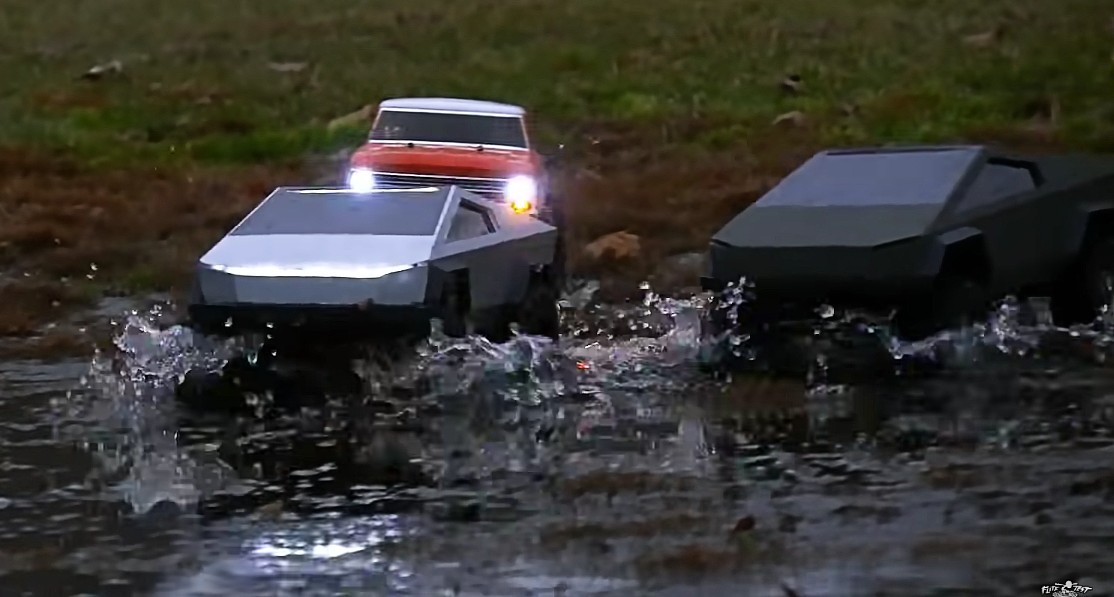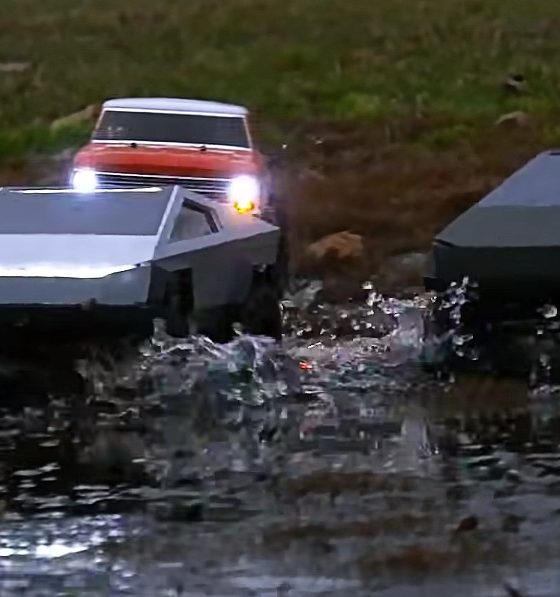

News
Tesla Cybertruck’s wading depth specs and features will be as crazy as its design
During a recent appearance at the Third Row Podcast, Tesla CEO Elon Musk quipped that in the Cybertruck stands unique in the market for bad*ss pickup trucks. Musk explained that this is due to the Cybertruck not really being a truck, but instead, a “freaking tank from the future.” And being a tank from the future, the Cybertruck will have water wading capabilities that are a bit out of the ordinary.
Rough and tough vehicles are expected to survive in the most unforgiving terrains. Being an off-road-capable all-electric pickup, the Cybertruck is designed to be as robust as possible. This means that the vehicle must be able to drive over water just as well as it would drive over gravel paths. Elon Musk’s recent tweets suggest that this will be the case. What’s more, the Cybertruck will even be able to float for some time when it encounters deep water.
The Cybertruck’s capability to wade through water is an invaluable feature that will likely be a key selling point for the upcoming vehicle. As indicated in the tweet that Musk recently responded to on Twitter, some pickup truck owners love fishing, and sometimes, that requires driving over some streams. It is then necessary for the Cybertruck to wade through water without damaging any of its internals. If the Cybertruck can wade through deep waters and even float for a bit, it would outclass the usual trucks that are used by fishing enthusiasts, such as the RAM and the F-Series.
Elon Musk’s comments about the Cybertruck being able to float for a while seems to be a reference to an incident back in 2016 that involved a Model S sedan encountering deep floodwaters in a tunnel. During the incident, the driver of the all-electric car was able to leave the area by using the Model S as a boat of sorts. Musk later noted on a tweet that while Tesla does not recommend using its vehicles like boats, its electric cars can survive in water for short periods, thanks to sensitive components like their powertrains being watertight.
Musk’s comment definitely seems accurate, as indicated by videos of Model S and Model X wading through deep floodwaters without any issues at all. It’s also pertinent to note that the Model S and Model X are not designed for off-road water wading activities, instead being city cruisers that are most at home on paved roads. Considering Musk’s comments, one cannot help but be a bit excited to see just how well the Cybertruck — a vehicle that’s actually designed for harsh conditions — does when it encounters water.
The Tesla Cybertruck is a vehicle that excites Elon Musk. He admits as much, recently noting that he cannot wait until Tesla starts building the truck. Musk may not be waiting much longer though, especially since several cities across the United States have already extended generous offers to Tesla for the all-electric pickup’s production facilities. The Tesla CEO has also mentioned some refinements to the Cybertruck’s design, such as a 3% reduction in physical size that would allow the vehicle to fit in a standard American garage.

News
Tesla FSD fleet is nearing 7 billion total miles, including 2.5 billion city miles
As can be seen on Tesla’s official FSD webpage, vehicles equipped with the system have now navigated over 6.99 billion miles.

Tesla’s Full Self-Driving (Supervised) fleet is closing in on almost 7 billion total miles driven, as per data posted by the company on its official FSD webpage.
These figures hint at the massive scale of data fueling Tesla’s rapid FSD improvements, which have been quite notable as of late.
FSD mileage milestones
As can be seen on Tesla’s official FSD webpage, vehicles equipped with the system have now navigated over 6.99 billion miles. Tesla owner and avid FSD tester Whole Mars Catalog also shared a screenshot indicating that from the nearly 7 billion miles traveled by the FSD fleet, more than 2.5 billion miles were driven inside cities.
City miles are particularly valuable for complex urban scenarios like unprotected turns, pedestrian interactions, and traffic lights. This is also the difference-maker for FSD, as only complex solutions, such as Waymo’s self-driving taxis, operate similarly on inner-city streets. And even then, incidents such as the San Francisco blackouts have proven challenging for sensor-rich vehicles like Waymos.
Tesla’s data edge
Tesla has a number of advantages in the autonomous vehicle sector, one of which is the size of its fleet and the number of vehicles training FSD on real-world roads. Tesla’s nearly 7 billion FSD miles then allow the company to roll out updates that make its vehicles behave like they are being driven by experienced drivers, even if they are operating on their own.
So notable are Tesla’s improvements to FSD that NVIDIA Director of Robotics Jim Fan, after experiencing FSD v14, noted that the system is the first AI that passes what he described as a “Physical Turing Test.”
“Despite knowing exactly how robot learning works, I still find it magical watching the steering wheel turn by itself. First it feels surreal, next it becomes routine. Then, like the smartphone, taking it away actively hurts. This is how humanity gets rewired and glued to god-like technologies,” Fan wrote in a post on X.
News
Tesla starts showing how FSD will change lives in Europe
Local officials tested the system on narrow country roads and were impressed by FSD’s smooth, human-like driving, with some calling the service a game-changer for everyday life in areas that are far from urban centers.

Tesla has launched Europe’s first public shuttle service using Full Self-Driving (Supervised) in the rural Eifelkreis Bitburg-Prüm region of Germany, demonstrating how the technology can restore independence and mobility for people who struggle with limited transport options.
Local officials tested the system on narrow country roads and were impressed by FSD’s smooth, human-like driving, with some calling the service a game-changer for everyday life in areas that are far from urban centers.
Officials see real impact on rural residents
Arzfeld Mayor Johannes Kuhl and District Administrator Andreas Kruppert personally tested the Tesla shuttle service. This allowed them to see just how well FSD navigated winding lanes and rural roads confidently. Kruppert said, “Autonomous driving sounds like science fiction to many, but we simply see here that it works totally well in rural regions too.” Kuhl, for his part, also noted that FSD “feels like a very experienced driver.”
The pilot complements the area’s “Citizen Bus” program, which provides on-demand rides for elderly residents who can no longer drive themselves. Tesla Europe shared a video of a demonstration of the service, highlighting how FSD gives people their freedom back, even in places where public transport is not as prevalent.
What the Ministry for Economic Affairs and Transport says
Rhineland-Palatinate’s Minister Daniela Schmitt supported the project, praising the collaboration that made this “first of its kind in Europe” possible. As per the ministry, the rural rollout for the service shows FSD’s potential beyond major cities, and it delivers tangible benefits like grocery runs, doctor visits, and social connections for isolated residents.
“Reliable and flexible mobility is especially vital in rural areas. With the launch of a shuttle service using self-driving vehicles (FSD supervised) by Tesla in the Eifelkreis Bitburg-Prüm, an innovative pilot project is now getting underway that complements local community bus services. It is the first project of its kind in Europe.
“The result is a real gain for rural mobility: greater accessibility, more flexibility and tangible benefits for everyday life. A strong signal for innovation, cooperation and future-oriented mobility beyond urban centers,” the ministry wrote in a LinkedIn post.
News
Tesla China quietly posts Robotaxi-related job listing
Tesla China is currently seeking a Low Voltage Electrical Engineer to work on circuit board design for the company’s autonomous vehicles.

Tesla has posted a new job listing in Shanghai explicitly tied to its Robotaxi program, fueling speculation that the company is preparing to launch its dedicated autonomous ride-hailing service in China.
As noted in the listing, Tesla China is currently seeking a Low Voltage Electrical Engineer to work on circuit board design for the company’s autonomous vehicles.
Robotaxi-specific role
The listing, which was shared on social media platform X by industry watcher @tslaming, suggested that Tesla China is looking to fill the role urgently. The job listing itself specifically mentions that the person hired for the role will be working on the Low Voltage Hardware team, which would design the circuit boards that would serve as the nervous system of the Robotaxi.
Key tasks for the role, as indicated in the job listing, include collaboration with PCB layout, firmware, mechanical, program management, and validation teams, among other responsibilities. The role is based in Shanghai.
China Robotaxi launch
China represents a massive potential market for robotaxis, with its dense urban centers and supportive policies in select cities. Tesla has limited permission to roll out FSD in the country, though despite this, its vehicles have been hailed as among the best in the market when it comes to autonomous features. So far, at least, it appears that China supports Tesla’s FSD and Robotaxi rollout.
This was hinted at in November, when Tesla brought the Cybercab to the 8th China International Import Expo (CIIE) in Shanghai, marking the first time that the autonomous two-seater was brought to the Asia-Pacific region. The vehicle, despite not having a release date in China, received a significant amount of interest among the event’s attendees.








